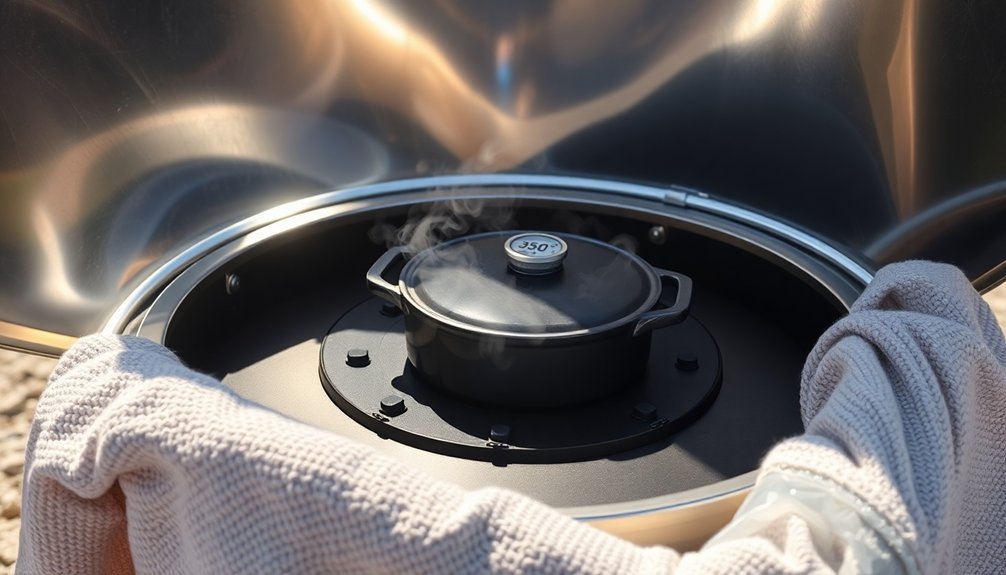You'll keep your solar oven hot by focusing on three proven elements. First, use multiple glazing layers, like double-paned glass panels, to trap heat and prevent it from escaping through convection. Second, incorporate strategic dark materials, such as black paint or dark clay on interior surfaces, which can absorb up to 95% of incoming solar radiation. Third, implement advanced insulation around the cooking cavity using materials like rockwool or polystyrene sheets to maintain high temperatures. With proper attention to these key components, you'll maximize your solar oven's heat retention and cooking efficiency. Let's explore how to implement these elements effectively.
Multiple Glazing Systems

Three essential components make up an effective multiple glazing system for solar ovens: double-glazed glass panels, an insulating air space, and a sturdy frame. You'll find that these components work together to trap more heat than single glazing, substantially improving your oven's thermal performance.
Your double-glazed system will include two panes of tempered glass with a carefully measured air space between them. This design reduces heat loss through both convection and radiation, helping you maintain higher cooking temperatures. The thickness of both the glass and air space is vital – you'll need to guarantee precise measurements for peak performance. High-temperature silicone caulk ensures that moisture and dirt cannot enter the space between glass panes.
When you're building your solar oven, you'll want to position the reflectors strategically to maximize sunlight capture. The glazing system works with both direct and diffuse solar radiation, so you won't need to make frequent tracking adjustments.
You can evaluate your system's effectiveness using two figures of merit (FOM): one measures thermal efficiency under no-load conditions, while the other assesses performance when the oven is fully loaded. This double-glazing approach gives you better tolerance for varying weather conditions and helps maintain consistent cooking temperatures.
Strategic Dark Material Placement
Strategic placement of dark materials fundamentally drives your solar oven's heat absorption capacity. Dark surfaces effectively convert sunlight into heat, making them essential for maintaining high temperatures in your solar cooker. High heat conductivity makes aluminum an excellent choice for the interior box material.
You'll want to focus on both the oven's interior and your cooking vessels to maximize heat absorption and retention.
- Black paint or dark clay on interior surfaces can absorb up to 95% of incoming solar radiation
- Dark-colored pots, especially thin ones, heat up faster and maintain cooking temperatures better
- Combining dark absorption surfaces with reflective elements can substantially boost heating efficiency
When selecting materials, you'll find that black construction paper, dark clay mixed with straw, or high-temperature BBQ paint on aluminum work exceptionally well. If you're using cooking vessels, opt for dark glass dishes or black cast iron pots with lids to trap heat effectively.
Remember to keep the oven's reflective surfaces clean and properly angled to direct sunlight onto your dark materials. For the best results, position your dark-colored cooking vessels in the center of the oven where they'll receive the most concentrated solar energy, and always use lids to prevent heat loss.
Advanced Insulation Design

Mastering insulation design elevates your solar oven from a basic cooker to a high-performance cooking system. You'll need to surround your cooking cavity with effective insulating materials on all sides except for the glazed surface.
Start by incorporating aluminum foil as a radiant reflector, then add layers of materials like spun fiberglass, rockwool, or even crumpled newspaper. For additional insulation, use polystyrene sheets to create an extra thermal barrier.
You'll achieve better results by implementing double glazing with glass or plastic, which cuts heat loss through the transparent surface in half. Make sure you're using a reliable vapor barrier on the innermost surface to prevent moisture damage.
When you're positioning insulation, focus on minimizing heat conduction between the inner and outer boxes.
Structure your design with the right proportions – a shallower box depth with the same solar collection area will give you higher temperatures by reducing heat loss area. You can create an effective border around your cooking area by taping down rolls of newspaper.
Remember to keep your insulating materials separate from structural components, and always test your improvements with an oven thermometer or infrared thermometer to verify their effectiveness.
Frequently Asked Questions
How Do Reflective Panels Affect Cooking Time During Early Morning Hours?
You'll need to adjust your reflective panels eastward in early morning hours. They'll concentrate limited sunlight, though cooking times are longer than midday due to lower sun intensity before 10 a.m.
Can Food Containers' Color Impact the Efficiency of Solar Cooking?
Yes, your food container's color substantially impacts solar cooking efficiency. You'll get better results with dark-colored containers since they absorb more solar radiation, while shiny containers reflect heat away, reducing cooking effectiveness.
What Maintenance Schedule Keeps a Solar Oven Performing at Peak Efficiency?
You'll need to clean your solar oven weekly, check reflectors monthly, and realign the position every 30 minutes during use. Replace damaged parts immediately and inspect for debris before each cooking session.
How Does Altitude Affect Solar Oven Temperature and Cooking Performance?
At higher altitudes, you'll get more intense UV rays and direct sunlight, which can boost your solar oven's performance. However, you'll need good insulation to offset cooler ambient temperatures affecting cooking times.
Which Foods Are Most Suitable for Overnight Solar Cooking Methods?
You'll find beans, legumes, and brown rice work best for overnight solar cooking. Stews, casseroles, and tough meats also benefit from the long, slow cooking process in your solar oven.
In Summary
You'll get the most efficient solar cooking results by combining multiple glazing layers to trap heat, strategically placing dark materials to maximize absorption, and implementing advanced insulation techniques. These three proven methods work together to maintain higher temperatures in your solar oven, letting you cook meals more effectively. When you've mastered these key elements, you'll transform your solar oven into a reliable, sustainable cooking solution.





Leave a Reply